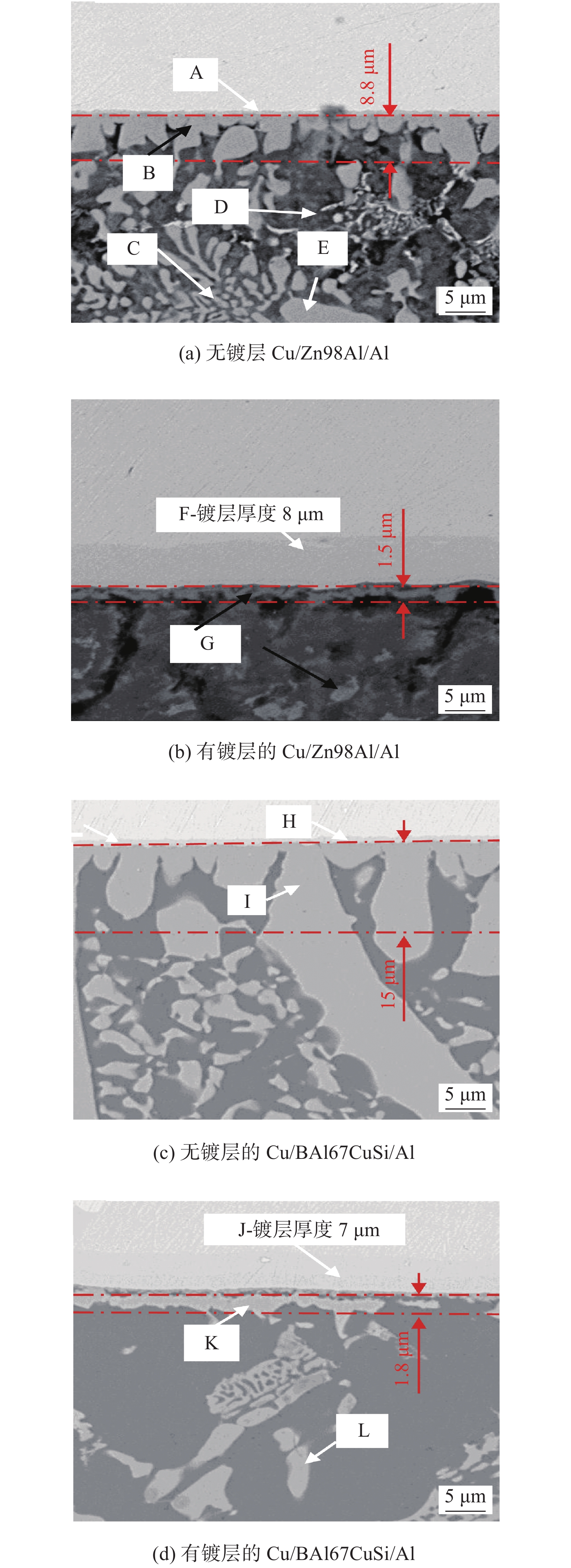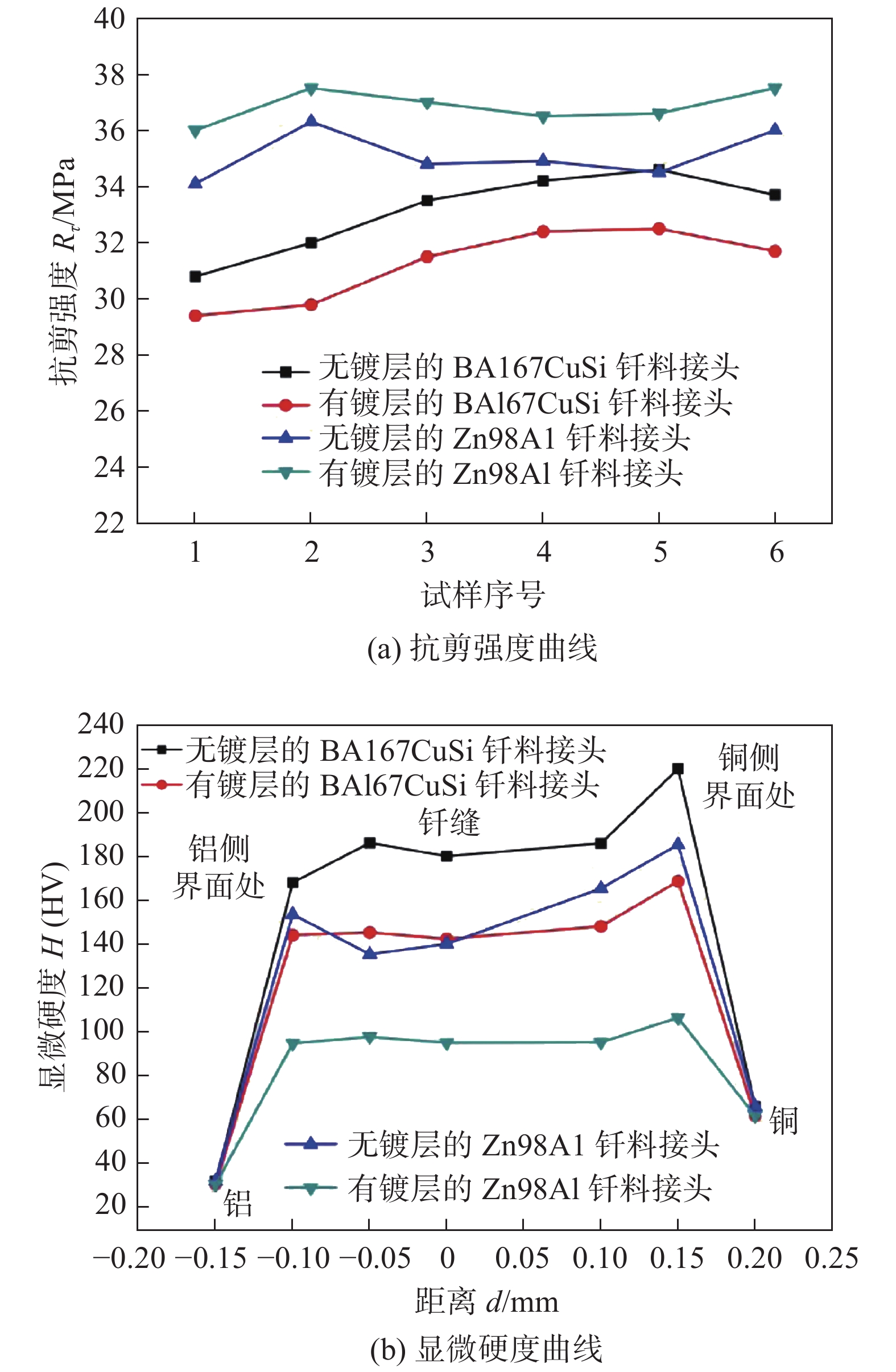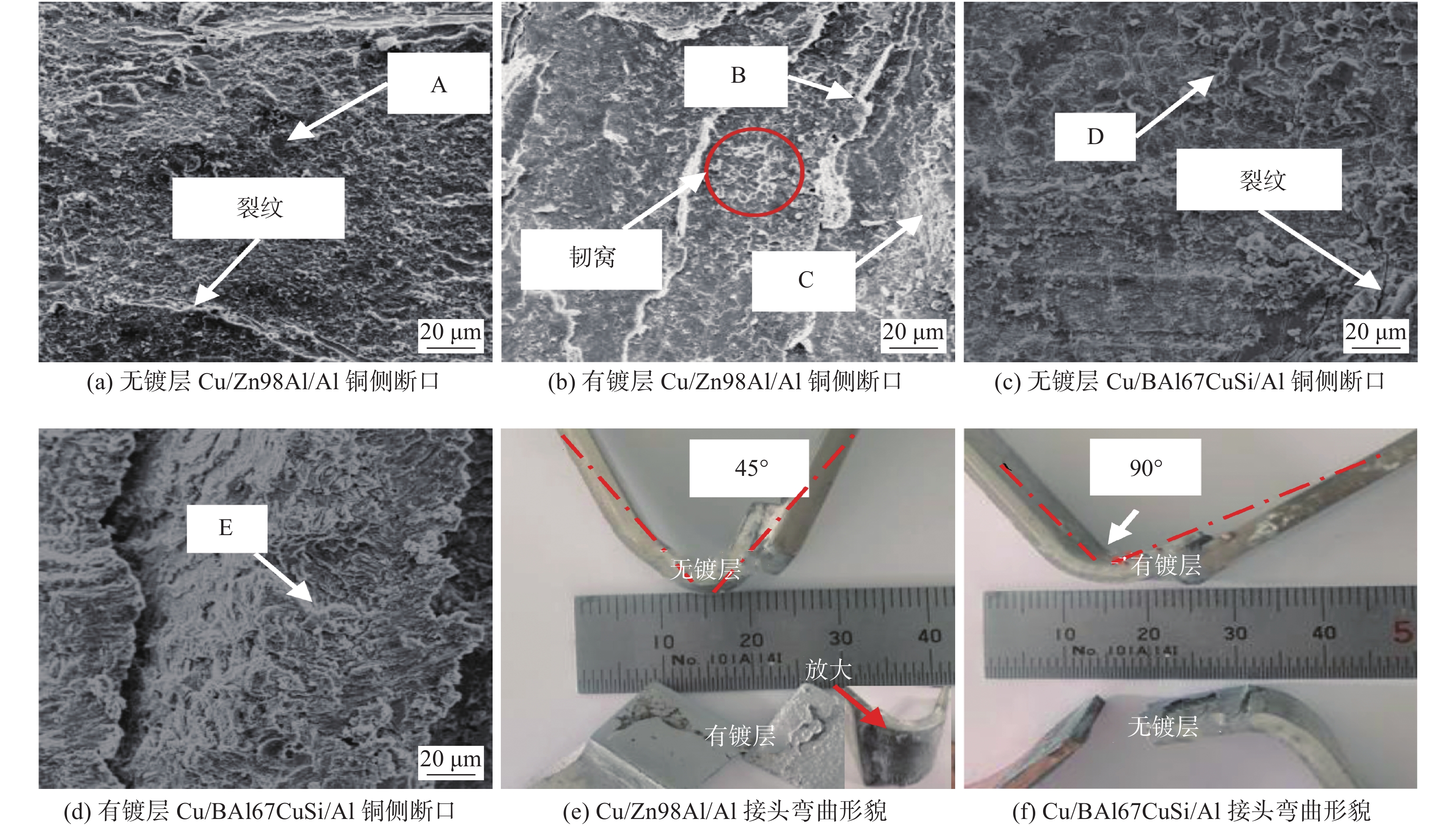Effect mechanism of Ni-P coating on the structure and properties of Cu/Al joints
-
摘要: 为了研究Ni-P镀层对Cu/Al异种金属钎焊界面反应的影响,首次采用Zn98Al和BAl67CuSi两种钎料对含/不含Ni-P镀层的T2紫铜与3003铝合金进行了高频钎焊,获得4种不同的钎焊接头,分别对接头Cu侧界面结构、抗剪强度、断口形貌、显微硬度及弯曲形貌进行了系统研究,并与无镀层接头进行对比. 结果表明,T2表面镀覆Ni-P后,Cu/Zn98Al/Al接头中Cu基体/钎缝界面结构由扩散层+8.8 μm厚的Cu3.2Zn4.2Al0.7化合物转变为1.5 μm厚的Al3Ni化合物,而Cu/BAl67CuSi/Al接头中Cu基体/钎缝界面结构由扩散层+15 μm厚CuAl2转变为1.8 μm厚Cu3NiAl6;与无镀层接头相比,镀覆Ni-P后,Cu/Zn98Al/Al接头强度略有上升,Cu/BAl67CuSi/Al接头强度略有下降,但两种接头的韧性均明显增强,力学性能试验结果与接头Cu侧界面微观组织转变规律相符. 最后建立了Cu/Al接头的界面反应模型,并阐明了Ni-P镀层对Cu/Al接头界面结构和力学性能的影响机制.Abstract: To investigate the influence of Ni-P coating on the interfacial reaction of Cu/Al dissimilar metal brazing, two brazing filler metals, Zn98Al and BAl67CuSi, were first used to braze 3003 aluminum alloy and T2 copper with or without Ni-P coating. Four different brazing joints were obtained. The Cu side interfacial microstructure, joint shear strength, joint fracture morphology, joint microhardness and joint bending morphology were systematically studied. Additionally, the joints without Ni-P coating were also used for comparison. The results showed that the interfacial structure of the Cu/Zn98Al/Al brazed joint was Cu/diffusion layer+8.8 μm thickness Cu3.2Zn4.2Al0.7. After the preparation of the Ni-P coating on the T2 copper surface, the interfacial structure transformed into Ni-P coating+1.5 μm thickness Al3Ni, which leaded to the higher strength and toughness. However, the interfacial structure of the Cu/BAl67CuSi/Al brazed joint changed from diffusion layer+15 μm thickness CuAl2 to Ni-P coating+1.8 μm thickness Cu3NiAl6, which leaded to the higher toughness but the lower strength. The effect mechanism of Ni-P coating on the interfacial reaction of Cu/Al joint was clarified. The mechanical properties test results were consistent with the microstructure transition of the Cu side interface of the joint. Finally, the interfacial reaction model of the Cu/Al joint was established, and the influence mechanism of Ni-P coating on the interfacial structure and mechanical properties of the Cu/Al joint was illustrated.
-
Keywords:
- Ni-P coating /
- Cu/Al joint /
- interface structure /
- strength /
- toughness
-
0. 序言
目前,铜是国内短缺资源,采用Cu/Al复合结构不但能缓解铜资源短缺,且能充分利用各自性能优势,如减重、降本、节能、降耗等. 因此Cu/Al异种金属的钎焊连接不可避免.
Zn-Al钎料和Al-Si钎料是Cu/Al钎焊的常用钎料,可使接头具有一定的力学性能[1-4]. 但是异种金属钎焊,特别是铜铝金属直接钎焊时,易在接头Cu侧形成大量硬脆化合物,导致接头强度降低、韧性变差,带来极大安全隐患[5-7].
国内外在Cu/Al接头界面化合物调控方面有大量研究报道. 张璐瑶等人[8]研究了Ni镀层对铜铝金属间化合物的影响,发现Ni镀层可使界面化合物厚度减小到17.05 μm. Li等人[9]研究了锌铝钎料表面Ni-Fe-P镀层的界面反应和扩散阻隔性能,证实Ni-Fe-P镀层可以抑制锌铝钎料界面化合物的互连. Najib 等人[10]研究了铜铝搅拌摩擦焊时超声波振动对接头金属间化合物的影响,发现超声波振动可减小化合物层厚度. Wang等人[11]研究了扩散钎焊参数对Cu/Al接头组织和性能的影响,结果表明,通过控制扩散工艺参数可控制界面化合物的生长. Santigopal 等人[12]研究了应用于APIX70钢上的Ni-P镀层,结果表明,Ni-P镀层以非晶结构为主,镀层致密,具有优异的耐高温渗透性,这给Cu/Al接头界面化合物的调控带来新的技术启示.
接头界面化合物存在阈值,约2 ~ 3 μm,大于阈值,性能恶化,阈值内性能变化不大. 从上述研究结果看,界面化合物调控措施主要有控制热输入、钎料元素抑制和镀层阻隔. 前两种效果有限,化合物层厚度仍较厚,而镀层阻隔效果较好. 但现有镀层多集中于铜上制备Ni镀层,且镀层作用机理不明. 因此开发新镀层,深入研究镀层作用机理,可为获得强韧接头提供理论基础.
文中设计含Ni-P镀层和不含Ni-P镀层的两种T2紫铜,采用Zn98Al和BAl67SiCu两种钎料高频钎焊T2紫铜与3003铝合金,研究了镀层对Cu/Al接头性能的影响,探讨了镀层作用机理.
1. 试验方法
试验材料为3003铝板和T2铜板,其尺寸均采用60 mm × 20 mm × 3 mm. 两种钎料分别为Zn98Al2和BAl67CuSi.
T2铜板表面镀层制备:砂纸打磨—除油除锈—水洗—化学镀Ni-P (PH=4. 8,温度80 ℃,时间20 min,测定镀层厚度在7 ~ 10 μm之间).
高频钎焊方法:将钎料裁切成合适片状预置于接头处,涂覆适量铝钎剂. 采用高频感应对Cu/Al搭接接头(搭接长度2 mm左右)进行加热,使钎料熔化、铺展、填缝,形成冶金结合. 图1为Cu/Al钎焊接头形貌.
利用电子万能试验机对Cu/Al接头进行抗剪强度测试,利用扫描电镜对接头断口形貌观察,并借助能谱分析仪对断口成分进行测定.
接头韧性评定方法:采用接头不同区域显微硬度值和接头三点弯曲试验最大弯曲角度进行评定.
2. 试验结果
2.1 Ni-P镀层对Cu基体/钎缝界面结构的影响
图2为Cu/Al接头中Cu基体/钎缝界面区的显微组织,表1为图2中不同区域的能谱分析结果. 从图2a可以看出,无镀层接头的Cu基体/钎缝界面区由扩散层A和锯齿状化合物B组成(厚约8.8 μm). EDS分析结果表明,该界面区由Cu(Zn)固溶体(见A点能谱结果)和Cu3.2Al4.2Zn0.7化合物(见B点能谱结果)组成. 靠近Cu3.2Al4.2Zn0.7界面层的组织主要由Zn-Al共晶(见C点能谱结果),α-Al和η-Zn固溶体(见D,E点能谱结果)组成. 从图2b可以看出,有镀层接头的Cu基体/钎缝界面区由灰色过渡带和一层很薄的化合物层组成,厚度约1.5 μm. 该界面层由Ni-P镀层(见F点能谱结果)和Al3Ni化合物(见G点能谱结果)组成. 与无镀层接头相比,有镀层接头Cu基体侧的Al3Ni界面层较薄,且靠近Al3Ni界面层的钎缝中η-Zn减少、α-Al固溶体增多、尺寸变大. 另外,Ni-P镀层中还含有微量的Al,Zn,Cu等元素(见F点),证明钎缝中Al,Zn原子、Cu母材中的Cu原子扩散到了Cu/Zn98Al/Al接头中的镀层中,镀层与钎缝、母材得到了充分的扩散和结合,镀层结合强度得到增强.
表 1 图2中不同区域的能谱分析结果(原子分数,%)Table 1. EDS results phases in the interfacial zones of the Cu/Al joints in Fig. 2位置 Zn Al Ni Cu P Si 可能的相 A 8.59 32.54 — 58.87 — — 扩散层 B 4.32 59.85 — 35.83 — — Cu3.2Zn4.2Al0.7 C 33.78 57.14 — 9.08 — — Zn-Al 共晶 D 11.69 82.15 — 6.16 — — D-α-Al E 62.79 15.07 — 22.14 — — E-η-Zn F 0.51 3.45 77.54 1.89 16.61 — Ni-P 镀层 G 2.27 71.72 24.53 0.14 1.34 — Al3Ni H — 43.17 0 56.38 — 0.45 扩散层r I — 64.12 0 33.98 — 1.90 CuAl2 J — 8.84 74.80 2.58 11.54 2.24 Ni-P 镀层 K — 63.01 8.80 27.13 — 1.06 Cu3NiAl6 L — 67.89 0.93 29.26 — 1.92 CuAl2 图2c,2d为Cu/BAl67CuSi/Al接头中Cu基体/钎缝界面区的显微组织. 从图2c可以看出,无镀层接头的Cu基体/钎缝界面区由扩散层H和其上的粗大笋状物I组成,厚度约15 μm. 该界面层由Cu(Al)固溶体 (见H点能谱结果)和CuAl2化合物 (见I点能谱结果)组成. 此外靠近CuAl2界面层的钎缝主要由黑色的α-Al相和白色的CuAl2化合物组成. 从图2d可以看出,有镀层接头的Cu基体/钎缝界面区由灰色过渡带和一层很薄的化合物层所组成,厚度约1.8 μm. 该界面层由Ni-P镀层(见J点能谱结果)和Cu3NiAl6 (见K点能谱结果)化合物组成. 与无镀层接头相比,Cu基体侧镀层处的Cu3NiAl6化合物层较薄,且靠近Cu3NiAl6化合物的钎缝中黑色α-Al相增多、互连成片,白色的CuAl2化合物大量减少、尺寸变小. 同时还可以看出,Ni-P层中还含有微量的Al,Si,Cu (见点J)元素,表明钎缝中的Al,Si原子和母材中Cu原子扩散到了Cu/BAl67CuSi/Al接头中的Ni-P层中,镀层与钎缝、母材得到了充分扩散结合,镀层结合强度得到了增强.
综上,Ni-P镀层可有效减少Cu基体近钎缝处的化合物层厚度,从而优化Cu基体/钎缝界面结构.
2.2 Ni-P镀层对Cu/Al接头强度及断口形貌影响
图3为接头力学性能曲线. 图3a为钎焊接头的抗剪强度曲线. 可以看出,无镀层的Cu/Zn98Al/Al接头抗剪强度平均值为35 MPa,有镀层的Cu/Zn98Al/Al接头的抗剪强度平均值为38 MPa,提高约8.5%. 这是因为Ni-P镀层使Cu/Al接头中Cu基体侧化合物层厚度明显减小,镀层中部分Ni原子扩散进入钎缝,起一定的强化作用. 无镀层Cu/BAl67CuSi/Al接头的抗剪强度平均值为34.1 MPa,有镀层的Cu/BAl67CuSi/Al接头的抗剪强度平均值为30 MPa,下降了约12%. 这是因为Ni-P镀层虽然使接头中Cu基体侧化合物层厚度明显减小,但同时也使钎缝中起弥散强化作用的CuAl2相大量减少. 尽管有微量Ni原子扩散进入焊缝进行强化,但微量Ni原子的强化作用较弱,不能弥补大量CuAl2相的减少所造成的接头强度损失. 由此可知,Ni-P镀层使Cu/Zn98Al/Al接头的抗剪强度略有上升,使Cu/BAl67CuSi/Al接头的抗剪强度略有下降.
图4为Cu/Al接头断口形貌和弯曲试验结果,表2为图4中不同区域的能谱分析结果. 其中图4a,4b为Cu/Zn98Al/Al接头中Cu侧断口形貌. 可以发现,无镀层接头Cu侧断口较平齐光亮,且有小裂纹,为典型穿晶脆性断裂. 断裂位置发生在Cu母材与钎缝界面处的金属间化合物层Cu3.2Al4.2Zn0.7 (见A点能谱结果). 有镀层接头Cu侧断口几乎看不到裂纹,且局部区域有小的韧窝,可见明显的解理面,为解理脆性断裂. 与无镀层接头相比,有镀层接头断裂位置发生在镀层与钎缝界面处的金属间化合物层Al3Ni,且Cu侧断面出现了大量的α-Al和Al3Ni (见B点、C点能谱结果). 由此可推断,有镀层的Cu/Zn98Al/Al接头断口形貌出现了局部的塑性转变.
![]() 图 4 Cu/Al接头断口形貌及弯曲试验结果Figure 4. Fracture morphology and bending test results of Cu/Al joints. (a) fracture morphology of Cu/Zn98Al/Al joint without coating; (b) fracture morphology of Cu/Zn98Al/Al joint with coating; (c) fracture morphology of Cu/ BAl67CuSi /Al joint without coating; (d) fracture morphology of Cu/ BAl67CuSi /Al joint with coating; (e) bending morphology of Cu/ Zn98Al /Al joint; (f) bending morphology of Cu/BAl67CuSi/Al joint of copper-aluminum joint
图 4 Cu/Al接头断口形貌及弯曲试验结果Figure 4. Fracture morphology and bending test results of Cu/Al joints. (a) fracture morphology of Cu/Zn98Al/Al joint without coating; (b) fracture morphology of Cu/Zn98Al/Al joint with coating; (c) fracture morphology of Cu/ BAl67CuSi /Al joint without coating; (d) fracture morphology of Cu/ BAl67CuSi /Al joint with coating; (e) bending morphology of Cu/ Zn98Al /Al joint; (f) bending morphology of Cu/BAl67CuSi/Al joint of copper-aluminum joint图4c,4d为Cu/BAl67CuSi/Al接头中Cu侧断口形貌. 可以发现无镀层接头Cu侧断口更加平齐光亮,其有大量密布裂纹,为典型穿晶脆性断裂. 断裂位置发生在Cu母材与钎缝界面处的金属间化合物层CuAl2 (见D点能谱结果). 有镀层接头Cu侧断口几乎看不到裂纹,有明显可见的解理面和河流花样,为解理脆性断裂. 与无镀层接头相比,有镀层接头断裂位置发生在镀层与钎缝界面处的化合物层为Cu3NiAl6 (见E点能谱结果).
2.3 Ni-P镀层对Cu/Al接头韧性的影响
为进一步研究显微组织对接头性能的影响,采用显微硬度计对Cu/Al接头母材区、界面区、钎缝中心区等不同区域进行硬度测试.
图3b为Zn98Al钎料和BAl67CuSi钎料钎焊Cu/Al接头的维氏硬度分布曲线. 图中x=0处为焊缝中心,正方向为紫铜,负方向为铝合金,每个点的显微硬度取自5个数据的平均值. 可以发现,与无镀层接头相比,有镀层接头的整个钎缝区显微硬度值均明显下降,特别是Cu母材侧界面区的显微硬度值大幅度下降. 还可以看出,钎缝中心的硬度值都比界面区的低,这是因为钎缝中心只含钎料元素,母材向中心扩散溶解的很少. 硬度曲线中Cu母材靠近钎缝一侧的峰值高于Al母材靠近钎缝一侧的硬度值,这是因为钎料与母材Cu的反应比较剧烈,在Cu侧近钎缝处形成了大量脆性化合物,导致Cu侧显微硬度值为峰值.
Ni-P镀层使得Cu/Al接头整个钎缝区显微硬度值明显下降,特别是接头中Cu母材侧界面处显微硬度值大幅度下降. 显微硬度值大幅度降低,意味着接头韧性会明显增强.
图4e,4f分别为Cu/Zn98Al/Al接头和Cu/BAl67CuSi/Al接头的弯曲试验形貌. 可以发现,两者无镀层接头在弯曲过程中均发生了脆断,无镀层接头的韧性较差. 相反,有镀层的Cu/Zn98Al/Al接头可以弯曲45°而不发生脆断,有镀层的Cu/BAl67CuSi/Al接头可以弯曲90°而不发生脆断. 图4e中放大形貌可以看出,有镀层的Cu/Zn98Al/Al接头弯曲90°时,弯曲应力已使接头钎缝处产生了密布应力裂纹,但钎缝仍未从Cu母材侧撕裂,证明了Ni-P镀层使接头的韧性明显增强.
2.4 Ni-P镀层对Cu/Al接头性能的影响机制
图5a,5b为无Ni-P镀层Cu/Zn98Al/Al接头的反应机理示意图. 可以发现,钎焊初始Al基体的Al原子、Cu母材的Cu原子均向焊缝中心扩散,而钎缝中的Zn原子向Cu母材侧扩散. 由于铜在铝中的扩散Al原子的扩散速度大于Cu原子的扩散速度,导致大量Al原子远距离扩散至母材Cu侧. Al原子在母材Cu侧聚集,与扩散至附近的Cu原子、Zn原子产生剧烈化合反应,导致钎缝近Cu侧先形成富Zn的Cu固溶体层,随着Al原子进一步增多,形成所示的锯齿状三元化合物Cu3.2Al4.2Zn0.7 (图5b). 该锯齿状三元化合物为硬脆相,严重恶化Cu/Al接头的韧性. 在钎焊过程中,由于Zn,Al之间无限互溶,Zn98Al钎料对铝母材溶蚀严重,导致大量Al原子进入钎缝,使Al母材近钎缝处Al原子富集,形成向焊缝内生长的块状α-Al固溶体.
图5c,5d为设有Ni-P镀层的Cu/Zn98Al/Al接头反应机理示意图. 与无Ni-P镀层Cu/Al接头相比,相同之处在于同样有大量Al原子在铝母材侧富集,形成图5d所示的向焊缝内生长的块状α-Al固溶体. 不同之处是母材Cu侧近钎缝处有Ni-P镀层. 由图2和表1中的点B和点G能谱分析结果可知,无Ni-P镀层的Cu侧近钎缝B点的Cu原子分数为35.83%,而设有Ni-P镀层的Cu侧近钎缝G点的Cu原子分数为0.14%. 可见,Ni-P镀层使钎缝中处于同样位置的Cu原子急剧减少.
Ni-P镀层的致密度高,是一道坚固屏障,阻挡了Cu母材中大部分Cu原子的扩散、渗透,导致Cu,Al原子几乎没有结合的机会,难以形成大面积的铜铝金属间化合物.
Ni-P镀层在阻挡Cu原子扩散的同时,还向钎缝中心扩散部分Ni原子. 钎缝主体为Zn-Al固溶体. Zn-Al固溶体为置换固溶体,基于Krikendall效应,在置换固溶体中,低熔点组元扩散快,高熔点组元扩散慢. 因此,Ni原子的扩散速度远远小于Al原子的扩散速度,二者在镀层与钎缝的镀层界面处聚合,形成含Ni的化合物Al3Ni,从而改变了Cu母材/钎缝界面结构.
Cu母材/钎缝界面结构的改变,导致界面金属间化合物的结构、形态发生改变,从而影响接头性能.
3. 结论
(1) T2铜板表面镀覆Ni-P后,Cu/Zn98Al/Al接头中Cu基体/钎缝界面结构由扩散层+8.8 μm厚的Cu3.2Zn4.2Al0.7化合物转变为1.5 μm厚的Al3Ni化合物;而Cu/BAl67CuSi/Al接头中Cu基体/钎缝界面结构则由扩散层+15 μm厚CuAl2转变为1.8 μm厚的Cu3NiAl6.
(2) T2铜板表面镀覆Ni-P后,Cu/Zn98Al/Al接头抗剪强度略有上升,Cu/BAl67CuSi/Al接头强度略有下降,但两种接头韧性均明显增强. 其中,Cu/Zn98Al/Al接头可弯曲45°,Cu/BAl67CuSi/Al接头可弯曲90°.
(3) Ni-P镀层改变了Cu,Al,Zn等原子扩散行为,使接头Cu侧化合物结构、形态、厚度发生变化,从而影响接头性能.
-
图 4 Cu/Al接头断口形貌及弯曲试验结果
Figure 4. Fracture morphology and bending test results of Cu/Al joints. (a) fracture morphology of Cu/Zn98Al/Al joint without coating; (b) fracture morphology of Cu/Zn98Al/Al joint with coating; (c) fracture morphology of Cu/ BAl67CuSi /Al joint without coating; (d) fracture morphology of Cu/ BAl67CuSi /Al joint with coating; (e) bending morphology of Cu/ Zn98Al /Al joint; (f) bending morphology of Cu/BAl67CuSi/Al joint of copper-aluminum joint
表 1 图2中不同区域的能谱分析结果(原子分数,%)
Table 1 EDS results phases in the interfacial zones of the Cu/Al joints in Fig. 2
位置 Zn Al Ni Cu P Si 可能的相 A 8.59 32.54 — 58.87 — — 扩散层 B 4.32 59.85 — 35.83 — — Cu3.2Zn4.2Al0.7 C 33.78 57.14 — 9.08 — — Zn-Al 共晶 D 11.69 82.15 — 6.16 — — D-α-Al E 62.79 15.07 — 22.14 — — E-η-Zn F 0.51 3.45 77.54 1.89 16.61 — Ni-P 镀层 G 2.27 71.72 24.53 0.14 1.34 — Al3Ni H — 43.17 0 56.38 — 0.45 扩散层r I — 64.12 0 33.98 — 1.90 CuAl2 J — 8.84 74.80 2.58 11.54 2.24 Ni-P 镀层 K — 63.01 8.80 27.13 — 1.06 Cu3NiAl6 L — 67.89 0.93 29.26 — 1.92 CuAl2 -
[1] Sun Shineng, Li Duanyang, Liu Dongyan, et al. Effects of Bi and Ce addition on tensile properties and corrosion resistance of Zn-15Al alloys by continuous casting and extrusion[J]. Materials Letters, 2020, 275: 1 − 4.
[2] Ye Zheng, Yang Hao, Huang Jihua, et al. A novel Zn-Al-Si corrosion resistant filler metal for Cu/Al brazing[J]. Materials Letters, 2017, 206: 201 − 204. doi: 10.1016/j.matlet.2017.07.025
[3] Yu Hua, Zhang Liangliang, Cai Fangfang, et al. Interface microstructure and growth mechanism of brazing Cu/Al joint with BAl88Si filler metal[J]. Vacuum, 2020, 181: 1 − 8.
[4] Niu Zhiwei, Ye Zheng, Huang Jihua, et al. Interfacial structure and properties of Cu/Al joints brazed with Zn-Al filler metals[J]. Materials Characterization, 2018, 138: 78 − 88. doi: 10.1016/j.matchar.2018.01.054
[5] 马潇天, 闫德俊, 孟祥晨, 等. 铝/钢搅拌摩擦焊金属间化合物调控研究进展[J]. 焊接学报, 2020, 41(7): 2 − 11. Ma Xiaotian, Yan Dejun, Meng Xiangchen, et al. Progress on the control of intermetallic compounds in aluminum/steel friction stir welding[J]. Transactions of the China Welding Institution, 2020, 41(7): 2 − 11.
[6] 李桓, 徐光霈, 张宇辉, 等. 2219/5A06异种铝合金焊接接头组织与性能相关性[J]. 焊接学报, 2020, 41(9): 8 − 15. doi: 10.12073/j.hjxb.20200328001 Li Huan, Xu Guangpei, Zhang Yuhui, et al. Correlation between microstructure and properties of 2219/5A06 dissimilar aluminum alloy welded joint[J]. Transactions of the China Welding Institution, 2020, 41(9): 8 − 15. doi: 10.12073/j.hjxb.20200328001
[7] Ming Zhu, Wang Kehong, Liu Zeng, et al. Effect of the cooling rate on the microstructure and mechanicalproperties of high nitrogen stainless steel weld metals[J]. China Welding, 2020, 29(2): 48 − 52.
[8] 张璐瑶, 武小娟, 孙焕焕, 等. 镀镍层对铜铝金属间化合物的影响[J]. 沈阳理工大学学报, 2019, 38(1): 16 − 19. Zhang Luyao, Wu Xiaojuan, Sun Huanhuan, et al. Effect of nickel plating on copper-aluminum intermetallic compounds[J]. Journal of Shenyang Ligong University, 2019, 38(1): 16 − 19.
[9] Li Liu, Han Zhang, Hao Zheng, et al. Influence of crystalline structure on diffusion barrier property of electroless Ni–Fe–P coatings in Zn–Al solder interconnects[J]. Journal of Alloys and Compounds, 2019, 804(10): 42 − 48.
[10] Najib A Muhammad, Wu C S, Tian Weihong. Effect of ultrasonic vibration on the intermetallic compound layer formation in Al/Cu friction stir weld joints[J]. Journal of Alloys and Compounds, 2019, 785: 512 − 522. doi: 10.1016/j.jallcom.2019.01.170
[11] Wang Xuegang, Li Xingeng, Wang Chengguo. Influence of diffusion brazing parameters on microstructure and properties of Cu/Al joints[J]. Journal of Manufacturing Processes, 2018, 35: 343 − 350. doi: 10.1016/j.jmapro.2018.08.020
[12] Santigopal Samanta, Charu Singh, Atanu Banerjee, et al. Development of amorphous Ni-P coating over API X70 steel for hydrogen barrier application[J]. Surface and Coatings Technology, 2020, 403: 1 − 12.
-
期刊类型引用(2)
1. 杨俊朝,黄冠,丁宗业,纠永涛,龙伟民,胡侨丹. 基于同步辐射与第一性原理计算的Al/Cu钎焊界面组织与接头性能研究. 铸造技术. 2024(03): 293-299 .  百度学术
百度学术
2. 张学智,黄玲玲,李云鹏,于卓立,曹新娜,宋路阳,安鹏涛,魏世忠. Ni镀层对Cu/Al钎焊接头界面组织与力学性能的影响. 河南科技大学学报(自然科学版). 2024(04): 23-29+4-5 .  百度学术
百度学术
其他类型引用(1)




 下载:
下载:




